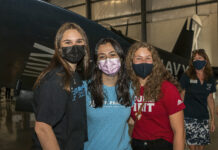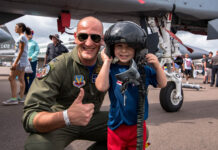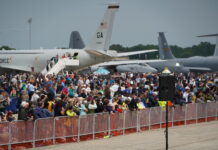As so many of us are discovering in so many different areas of our lives, last year’s terrorist attacks – shocking as they were for the death and destruction they caused during a few hours on one September morning – continue to disrupt, confuse, and destroy months later.
And the air show community has not been spared. The last two months of last year’s air show schedule were decimated. By early April, sixteen military bases in the United States and Canada had cancelled their air shows and open houses. Most identified the increased workload – and, in particular, the dramatically increased airlift requirements — that came with the war on terrorism as the principal reason for their cancellation.
But even as the organizations that serve as the infrastructure for the North American air show community work to overcome the financial and operational problems created by these cancellations, the military has made an impressive commitment to the air show community generally and to the 2002 air show schedule specifically.
A few examples:
- Just over a dozen military shows have cancelled, but dozens more have not and are moving ahead aggressively with plans to host an air show on their base this year.
Naval Station Norfolk, the east coast’s largest naval base, went to extraordinary lengths to develop a security plan that will allow them to have their show on base as scheduled in April. Other Navy and Marine Corps bases are using both the plan and the precedent to move ahead with their shows. The Air Force has developed a similar security plan that is making it possible for most shows to be held if they have the necessary manpower.
- Even as he was managing his service’s portion of the war on terrorism, General John Jumper, Chief of Staff of the United States Air Force, took time to issue a statement that unequivocally pronounced his expectation that air shows on Air Force bases would go on as scheduled in 2002. “To barricade ourselves within the confines of our bases would give the terrorists a moral victory while sending the message to the community that we live in fear. We have the more difficult task of both protecting our vital resources and making every effort to demonstrate our openness, our strength, and our competence to a public that needs to be reassured of our ability to protect and defend them.”
The Assistant Secretary of Defense for Public Affairs sent out a similar message several days later.
- In early March, the United States Air Force Air Combat Command (ACC) committed its two-star director of operations, ten aircraft, twenty fighter pilots and another two-dozen support personnel to four days of Heritage Flight training and practice. A few days later, ACC Commander General Hal Hornberg attended the U.S. Air Force Thunderbirds acceptance show. All this from the ACC senior leadership directly responsible for coordinating the Air Force’s involvement in the war on terrorism.
- The Blue Angels, the Thunderbirds, the Snowbirds, and the various single-ship tactical demonstration teams have all planned a full schedule of air show appearances.
Meanwhile, some of the military pilots who have been waging war on terrorism on our collective behalf are beginning to rotate back home. A few are former jet team members or single-ship demo pilots. But all of them are clear that waging war against the enemies of freedom is precisely what they were trained to do. From the B-2, F/A-18, and F-14 pilots actually dropping the bombs to the airlift pilots and crews who are supplying them with the ordnance they need to conduct this war, they are enthusiastic about the role they are playing in neutralizing this threat to their families, friends, and fellow citizens.
Even as we share in their enthusiasm, we should recognize that the free world is in a no-kidding war with terrorists, that this war might cause some air show-related hardship, and that military leadership in both the United States and Canada is going well beyond what could reasonably be expected of them in their efforts to continue to conduct and participate in air shows this year.
In fact, with very few exceptions and despite some of the problems that it might cause in our business this year, the military’s commitment to air shows is a testament to how seriously they take this business and to the value that they put on their involvement in air shows.
Now is not the time to be complaining about the small number of cancelled shows or the relative difficulty in securing military static display aircraft. We should be making it clear to the military how much we appreciate all that they do to support both military and civilian air shows. Organizationally and individually, they’ve got hundreds of reasons not to, but they’re doing it anyway. And that says a lot about them and a lot about their commitment to both their mission and the air show business.








